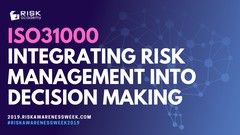Наши популярные онлайн курсы
Welcome to the third installment of the RISK AWARENESS monthly newsletter. Since the last edition the war in Ukraine happened and it is an absolute disaster. I am doing what I can to help here in Spain and I hope you help as well.
In this newsletter I wanted to share career changing and controversial videos from RAW, practical steps on implementing risk-based decision making, another important article on risk management and one of my favourite books on RM2.
Sam Savage, Executive Director of ProbabilityManagement.org, author of the Flaw of Averages – Why we Underestimate Risk in the Face of Uncertainty, Adjunct Professor in Stanford University’s School of Engineering and a Fellow of the Judge Business School at Cambridge University, will demonstrate how ignoring uncertainty in business plans and investment proposals leads to bad decision making. This powerful workshop will explain how businesses all over the world can improve performance by moving from averages to an unambiguous expression of uncertainty called a SIP.
The Flaw of Averages is a set of systematic errors that occur when uncertainties are represented by single average numbers. Sam will show how free SIPmath cures the Flaw of Averages by replacing single numbers in calculations with arrays of thousands of numbers. This lets you calculate the chances of achieving your goals in native Excel, R, Python or you favourite analytical platform.
You can now watch the best risk management workshops from RAW grouped by theme https://riskacademy.vonza.com/
Free access to RAW for Ukrainians forever https://riskacademy.blog/free-access-to-raw2020-and-raw2021-for-ukrainians-forever/
Provide tools to the decision makers or perform risk analysis on key decisions yourself – this is an important step to decide whether the risk team will become a methodology and monitoring centre and the actual risk analysis will be performed by decision makers or the risk team will become the analysis support centre and will perform all risk analysis themselves given the decision makers just the outputs. It’s a complex decision. If the decision makers are not mature, don’t have strong quant skills and are very biased, then risk team must become the analysis support centre and perform all risk analysis. Here is important to work with internal auditors to make sure risk analysis quality is sufficient to support decision making. This is pretty basic stuff but if decision science is new to you, I recommend reading good books that had all the answers for the last 10+ years.
While working on the project in the Middle East recently the RISK-ACADEMY team came up with what looks like the best risk identification template I’ve seen in a long time. This is what a good risk register should look like, if there was ever a need for one. Possibly the best risk assessment template
Decision Quality: Value Creation from Better Business Decisions. Dr. Carl Spetzler is a leader in the field of decision science and has worked with organizations across industries to improve their decision-making capabilities. He and his co-authors, all experienced consultants and educators in this field, show you how to frame a problem or opportunity, create a set of attractive alternatives, identify relevant uncertain information, clarify the values that are important in the decision, apply tools of analysis, and develop buy-in among stakeholders. Their straightforward approach is elegantly simple, yet practical and powerful. It can be applied to all types of decisions.
RAW2022 is scheduled for October. Now is your chance to nominate speakers or topics. Simply comment below. Also, if you are aware of any RM2 events coming up do let me know and I will include in the next newsletter.
You can now watch the best risk management workshops from RAW grouped by theme https://riskacademy.vonza.com/
3000+ risk practitioners have completed our online risk management and decision making courses, check them out https://www.udemy.com/user/alexsidorenko/
What’s next? What would you like to see in the next months newsletter?
Check out other decision making books
RISK-ACADEMY offers online courses

+ Buy now
Informed Risk Taking
Learn 15 practical steps on integrating risk management into decision making, business processes, organizational culture and other activities!
19,999,99

+ Buy now
ISO31000 Integrating Risk Management
Alex Sidorenko, known for his risk management blog http://www.riskacademy.blog, has created a 25-step program to integrate risk management into decision making, core business processes and the overall culture of the organization.
199,999,99

+ Buy now
Управление рисками
В этом коротком и очень увлекательном курсе, Алексей Сидоренко расскажет о причинах внедрения риск менеджмента, об особенностях принятия управленческих решений в ситуации неопределенности и изменениях в новом стандарте ИСО 31000:2018.
19,999,99

































